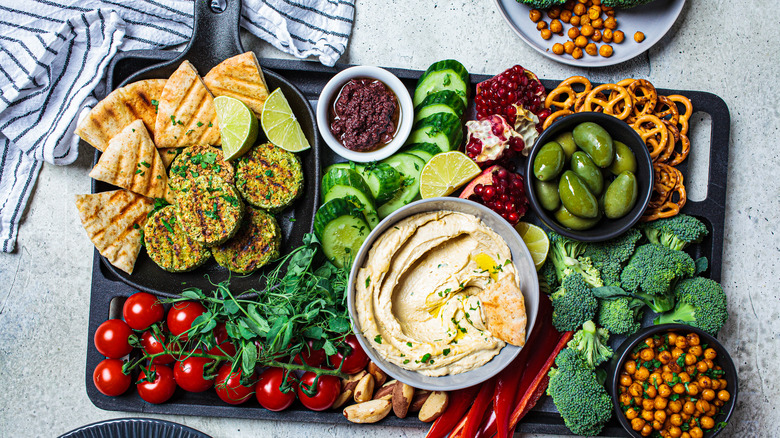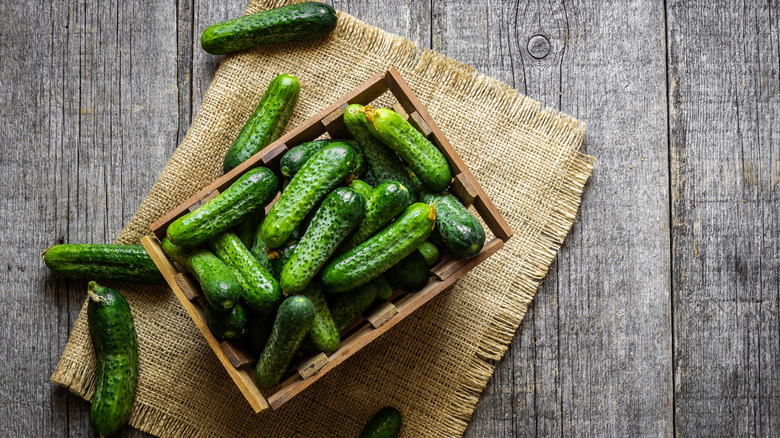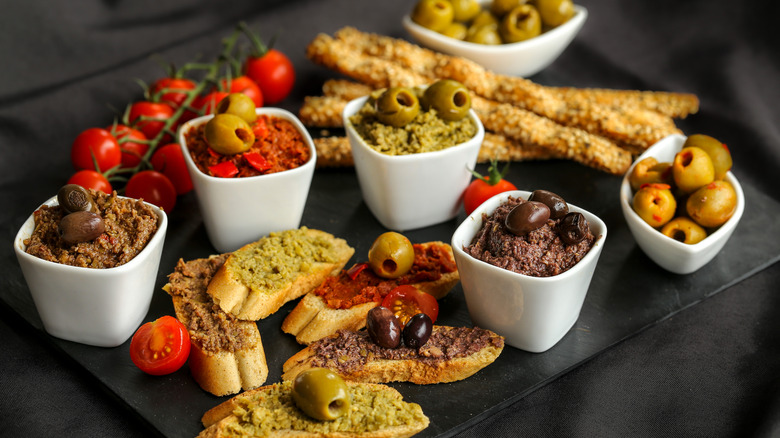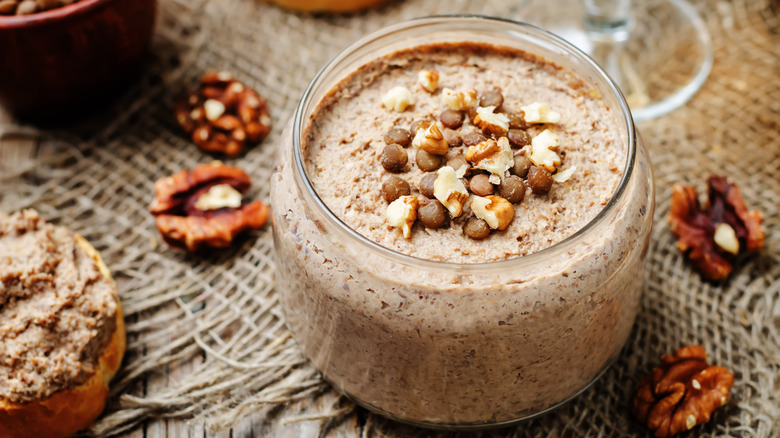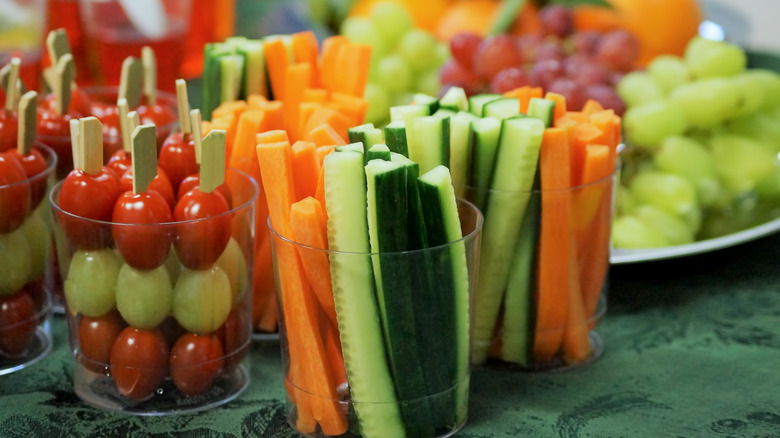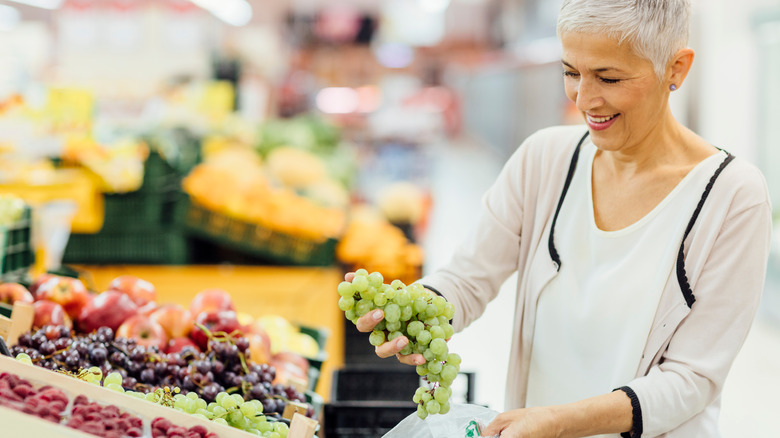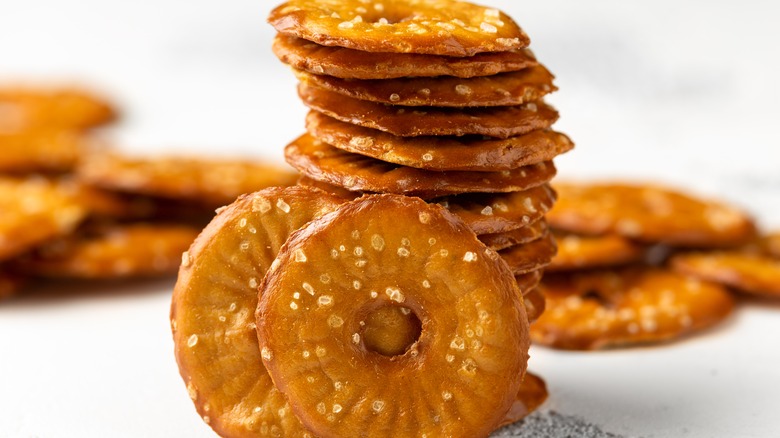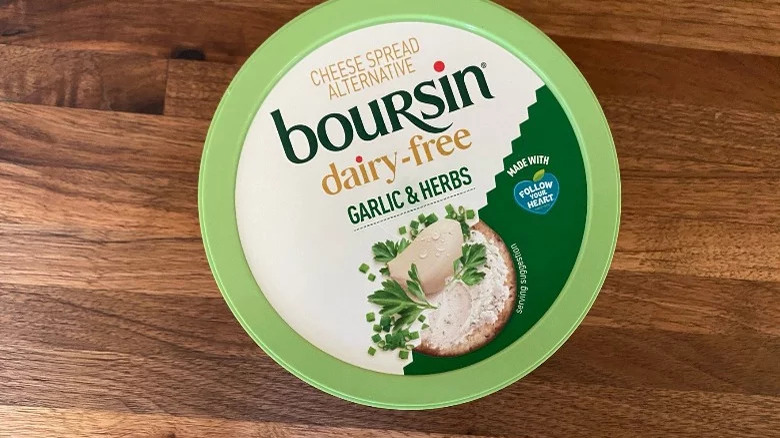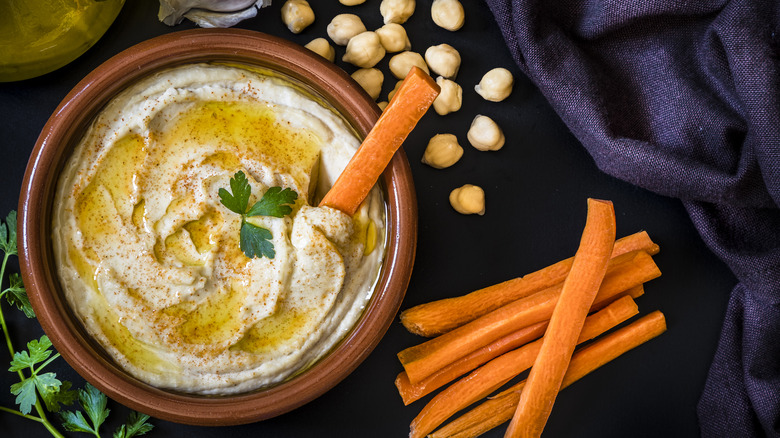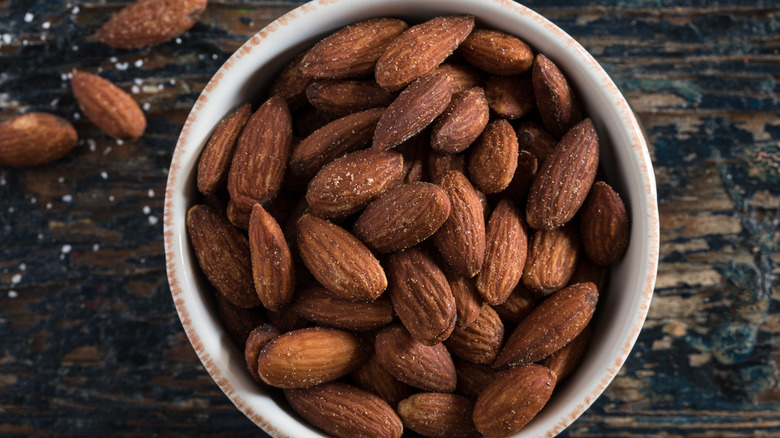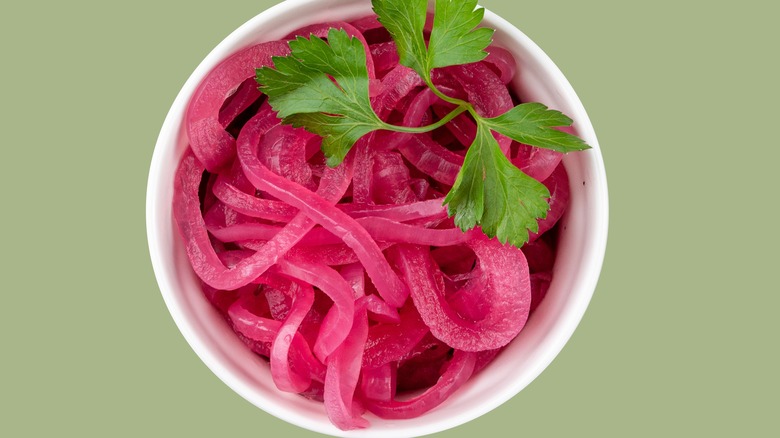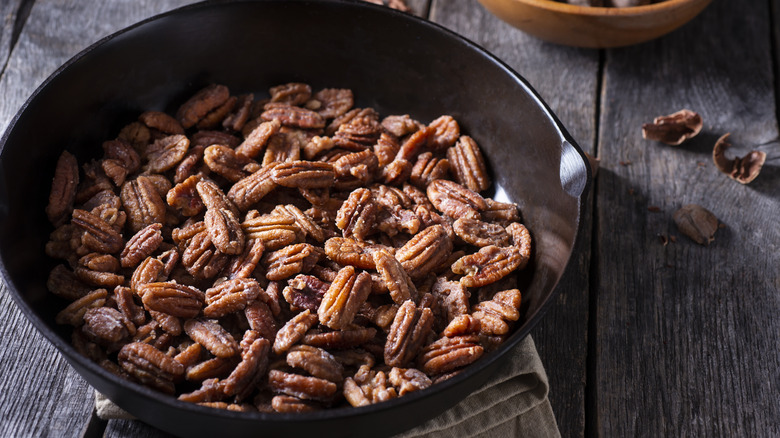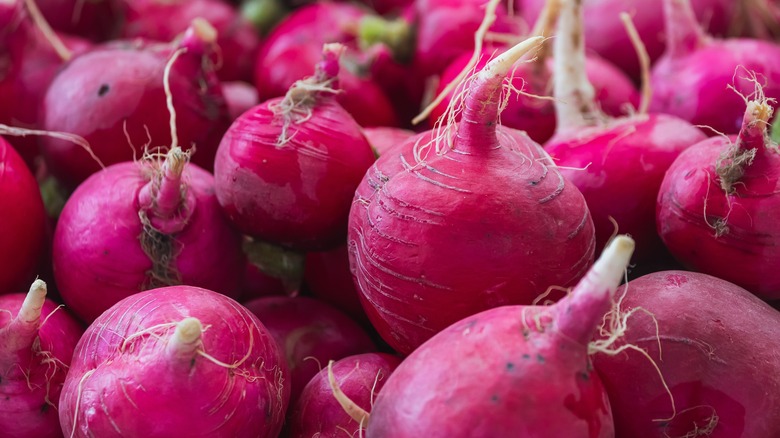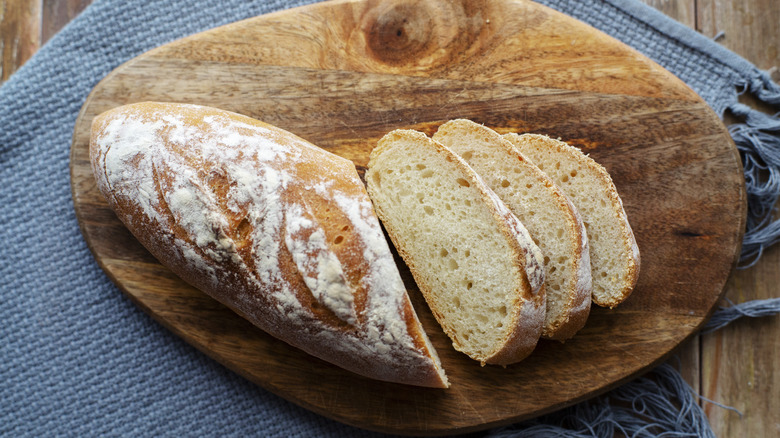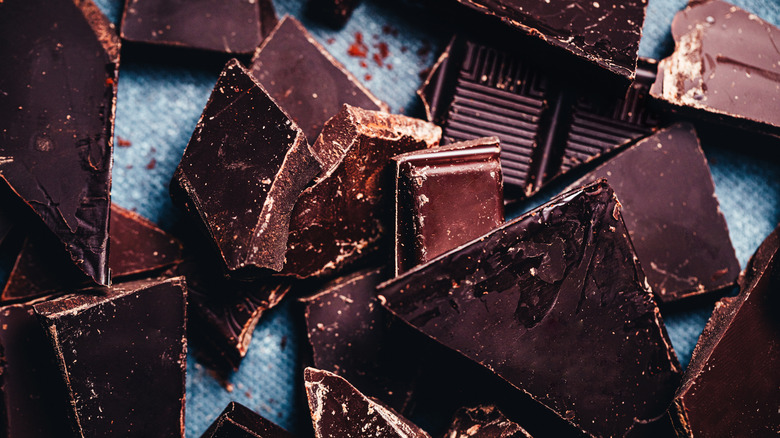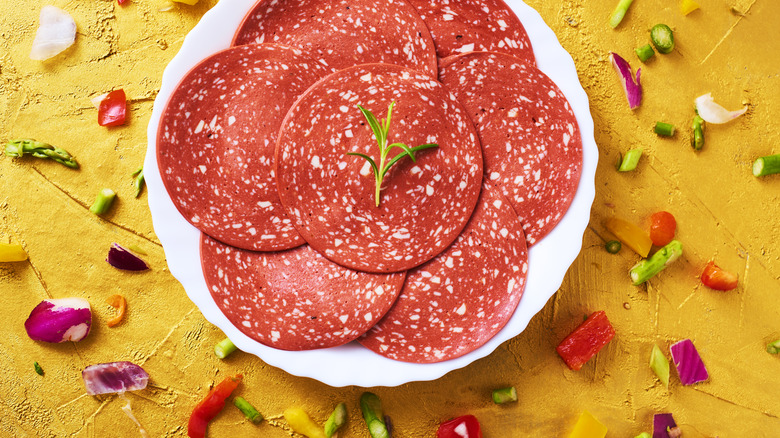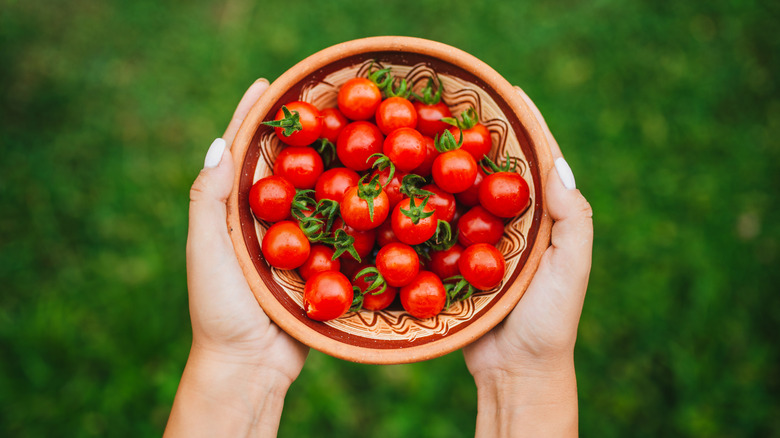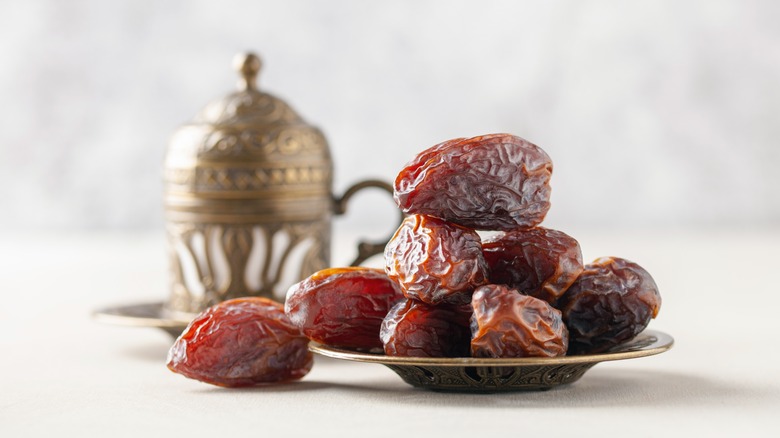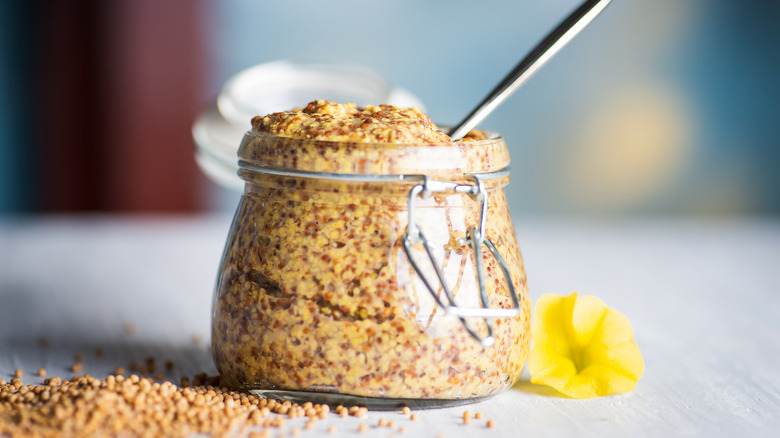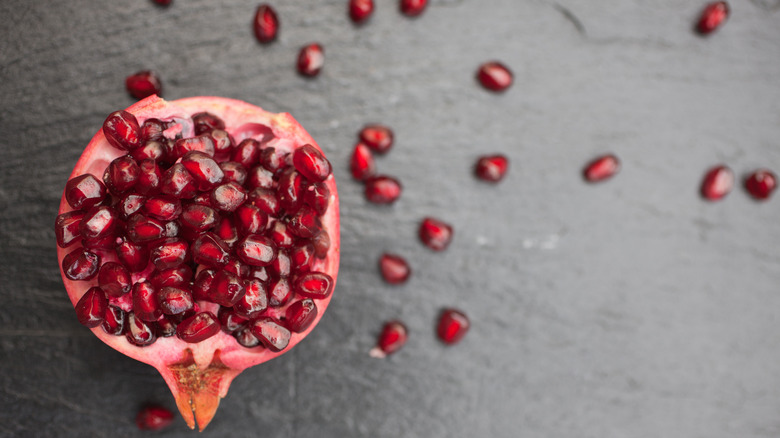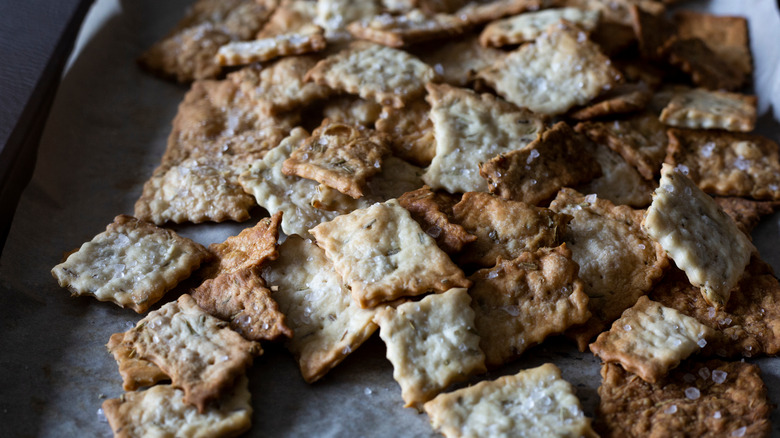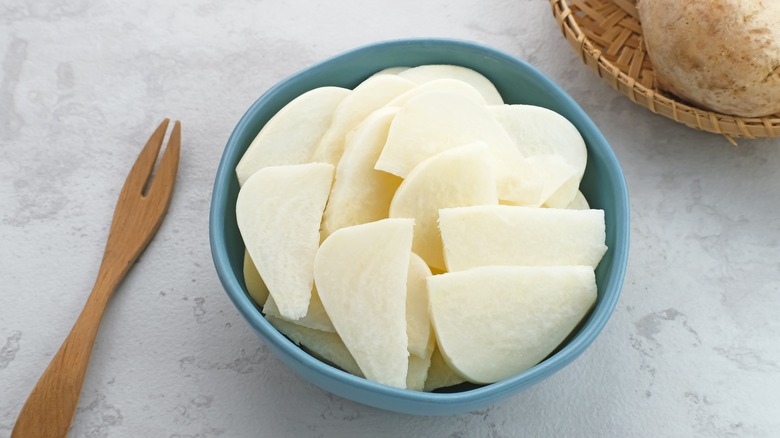21 Essential Tips For Assembling A Plant-Based Charcuterie Board
Charcuterie is the quintessential life is what you make it plate. While charcuterie can technically mean a plate of sliced cheddar, a few stale crackers, and some prosciutto sheets, it means a lot more to us. These massive plates were first assembled in France in the 15th century. From its humble meat-and-cheese origins, the dish has since evolved to include far more ingredients — it's an art form that can also incorporate non-animal-based foods into a mosaic of colors, textures, and flavors.
The key to building a charcuterie board is to create a balance between color, texture, and flavor. Aim to include the entire spectrum of flavors (sweet, savory, umami, bitter, and sour) across your board components, as well as creamy, crunchy, and juicy elements. We've created a handy guide on how to find these components in animal-free products. Additionally, many of these spreads, veggies, and products are gluten-free or can be substituted with gluten-free alternatives to satisfy every guest at your gathering.
Think sour with pickles
Since a charcuterie board is all about pairing complementary flavors with one another, it's no surprise that pickles made our list of must-have sour items. Full-sized cucumbers can be visually intrusive and take up too much space on your board, so we recommend going with a small cucumber that still packs the flavor. Gherkins are always a solid choice, whether as fresh cucumbers or made into pickles.
You can make classic bread and butter pickles by combining salted, mandolined pickles with apple cider vinegar, white vinegar, sugar, and seasoning like mustard seeds, celery seeds, and cucumbers. These pickles will be ready to eat in about a day, but letting them brine for longer will increase their flavor substantially. Don't forget to keep a small serving fork handy so your guests can transfer the pickles from the jar to their plates.
Veganize an olive tapenade
We're going to be frank here and say that olive tapenade is an ingredient that doesn't always get along with us. Olives have a salty, intrusive flavor, and the texture can resemble hummus that hasn't been pureed enough. If you and your guests can stomach it, consider adding a small container of tapenade to your charcuterie board.
Olive tapenade is actually made of Kalamata olives, capers, olive oil, and anchovies — but you can make a vegan rendition by omitting the fishy element and replacing it with an umami-rich ingredient like roasted garlic or sun-dried tomatoes. We also recommend adding a small dish of olives to your board for any guests who have an affinity for this divisive fruit. Pair your tapenade with fresh baguette slices and your favorite (vegan) wine.
Make a vegan pâté with mushrooms
Pâté is another food that is off-putting to many — often because of the unpleasant smell and gamey flavor of the liver. However, there is an earthy pâté swap that will invigorate your taste buds and doesn't involve butchering an animal.
You can use mushrooms as a flavorful replacement for the umami profile of the spread. Add your mushrooms (portabello, shiitake, or crimini work well) with a bit of MSG, vegan fish sauce, and plant-based butter to a blender or food processor and hit the switch. The ideal texture of the spread is smooth and creamy, so it may take a few minutes and a couple of spatula swipes to get there. You may also consider adding some garlic for a fresh bite.
Slice up veggies to please meat and plant-based eaters alike
Sliced vegetables are a key component of any charcuterie board because they add a pop of color, crunchy texture, and brightness to some otherwise heavy spreads. Our go-to sliced veggies include carrots, cucumbers, and celery since they're relatively inexpensive and keep for a while after slicing without browning.
The best way to organize sliced veggies on your charcuterie board is to stack them vertically in a jar rather than flair them out on the board. To increase the visual appeal of your charcuterie tray, try using different types of cuts like julienning, dicing, and cubing to add some depth and diversity.
Add some grapes for a snappy texture
Grapes are one of the most underappreciated items on a charcuterie board. Not only are these fruits brightly colored and uniquely shaped, but they are also easy to eat in a single bite. There are many different types of grapes to consider adding to your charcuterie board, including the sweet yet tart jubilee grape, the confectionary and crisp cotton candy variety, and the seedless Centennial type.
When you're buying grapes at the store to make your board, always look for firm grapes rather than bags that are mostly limp or sticky. The easy way to pick ripe grapes without sneaking a taste is to look for a solid color — in other words, green grapes should look green rather than pale. Ripe fruit will also remain attached to the stem when you pick it up rather than cascading down into the bag. If you notice a white powder on the grapes, fear not. This is called the bloom, and it helps prevent the grapes from decaying as they ripen. It is safe to eat, but you can also wash it off before assembling your board.
Choose a dippable pretzel
We mean it when we say that pretzel slims (or thins, depending on where you're shopping) are so much better than any other type of pretzel. Not only do you get the perfect crunch that you would from a bag of Snyder's classic twists, but these pretzels are much easier to scoop spreads and toppings with. Plus, you can shop for these pretzels in other flavors besides the classics, such as cinnamon sugar for a sweet dessert charcuterie board or everything seasoned for a savory upgrade.
You won't miss cheese with a vegan Boursin
Vegan Boursin? Although you might be skeptical about how a spreadable Gournay cheese can be veganized, we unequivocally recommend adding this spread to your next charcuterie board. Boursin's dairy-free garlic & herb cheese is made with coconut oil and starches, so it spreads just like a soft cheese would. It's also packed with notes of parsley and chives, which makes it an herby addition to any cheese board. In fact, we even think it's great enough to put on a normal cheese board and not tell anyone it's vegan.
The Boursin dairy-free cheese was one of the best vegan cheeses we've ever tasted, especially when spread on a thinly sliced baguette or a cracker. However, you might need to give the cheese a quick stir for optimal texture before serving.
Add hummus for protein and fiber
Hummus deserves a special place in our hearts as one of the all-time best vegan spreads. Not only is creamy hummus simple to make at home, but it's also relatively low-cost since you only need canned chickpeas, tahini, oil, and water. You can customize your hummus from there to include other ingredients like garlic, roasted red peppers, or lemon zest. If you're making a dessert-themed board, you may even whip up a dessert hummus with a scoop of cookie butter, a sprinkle of cinnamon, or a drizzle of maple syrup.
To serve your hummus, we recommend piling it into a small dish and adding a splash of olive oil on top. If you're making a garlic hummus, you may also consider adding a chopped garlic or parsley garnish.
Roasted almonds open up endless opportunities
Roasted almonds are the crunchy addition that your charcuterie board needs. We recommend using smoked or roasted nuts rather than raw almonds for a better flavor and texture. With almonds, you aren't limited to boring sea salt. Add an element of spice with wasabi nuts or a smoky undertone with a mesquite-smoked variety.
If you're feeling adventurous and want to try roasting your own almonds, you'll only need a parchment-paper-lined pan and the raw, skin-on almonds. Place the almonds in a single layer and bake until fragrant. Once you remove the roasted almonds from the oven, toss them in seasoning (we love cumin, sea salt, and cayenne) and cool before serving. These almonds are sublime for snacking, and you might want to reserve a little extra for yourself.
Pickled red onions can provide a pop of color
Pickled red onions are the perfect condiment on a burger or a hot dog, but there's no reason why this pink-hued veggie shouldn't make its way onto your charcuterie board, too. For an ultra-flavorful, sugar-free pickled red onion recipe, add red onion rounds to a jar with chopped garlic, apple cider vinegar pickling liquid, peppercorns, and salt. Once they're in the jar, your pickled red onions will need to be refrigerated for about three hours so the pickling brine can flavor and soften the alliums and bring out their flavor.
Candied pecans add sublime sweetness
There are many sublime ways to add sweetness to your charcuterie board — and one of those is through candied pecans. Although you can coat pecans in savory spices, the fattiness of the pecan really lends itself best to sweet flavors like maple, brown sugar, and cinnamon.
Baked candied pecans typically involve egg whites, so your best bet for a plant-based spin is to make stovetop candied pecans instead. Combine the sugar, salt, vanilla, and water in a skillet until syrup forms before adding in the nuts. From there, cool the nuts on a parchment-paper-lined pan and transfer them to an airtight container. These nuts don't last much longer than a week, so you should be sure to add them liberally to your board.
Radishes are mustardy and crisp
Radishes are one of our favorite crunchy veggies to add to a charcuterie board. Raw radishes, especially red radishes, have a garlic-like bite with a peppery undertone. If you're looking for a more mild flavor, search out daikon radishes in your local grocery store. You can also opt for French breakfast radishes, which are excellent when salted and pureed with butter in a spread called radis beurre à tartiner — just don't forget the fresh slice of baguette to go with it.
When serving raw radishes, you should always slice them in halves, quarters, or rounds rather than leaving them whole in order to balance out the spiciness; you might even leave a bit of the green on top for easy eating. For perfectly sized watermelon radish rounds, pull out your mandolin and get to work.
Bread is an essential
Bread is an important element to have on your charcuterie board because its softness contrasts with the crunchiness of other crackers. The most common bread selections for a board include French baguettes, sourdough, or crunchy artisan ciabatta. Depending on the spreads on your board, you may also consider adding a flavored loaf, like Kalamata olive or raisin bread. Regardless of the type of bread you select, you should always be sure to cut the bread into two or three bite slices for easy eating.
You'll also need to be aware of the arrangement of the bread on your board. It's very easy for your baguette slices to overtake the blank space on your board when you're assembling it. We recommend adding the spreads and crunchy ingredients to your board first and tucking the slices of bread in the corners and on the sides to fill up the rest of the space.
Dark chocolate will cleanse the palate
Dark chocolate is a viable option for savory and sweet charcuterie boards alike. You can select a brand with a low sugar content and high cacao for a darker flavor or opt for a more kid-friendly chocolate.
Some of our favorite plant-based dark chocolate brands include the Lake Champlain Chocolates semi-sweet dark chocolate bar (57% cacao) or dark chocolate bar (72% cacao), which are both USDA-certified organic and made with vegan ingredients. If you prefer creamier chocolate, try the Endangered Species oat milk dark chocolate bar (55% cacao), which has the smoothness of milk chocolate but the extra bite of the cacao.
Chop your chocolate bar up into small pieces and serve it with the rest of your board accompaniments. Since it's not the predominant flavor on your board, it likely won't take up too much space.
Use vegan pepperoni as a meat-free alternative
Vegan pepperoni is a meaty addition to a plant-based charcuterie board. Depending on the brand you purchase, you'll find the meatiness stemming from ingredients like vital wheat gluten, beans, and tofu. There are often many different options for plant-based meats in grocery stores; look for brands like Sweet Earth Foods or Field Roast for a delicious, meaty accompaniment to your plant-based charcuterie board.
If you want to try making your own vegan pepperoni at home, we recommend adding paprika, tomato paste, and red pepper flakes to bump up the heat an extra notch. You can also play with the proteins and add a bit of soy protein or bean puree to get a chewy texture that is more reminiscent of meat-based pepperoni.
Cherry and grape tomatoes can be eaten in a single bite
Cherry and grape tomatoes are what we like to call one-bite-wonders. Each fresh tomato is filled with a pop of juice and seeds that make eating them an experience. While you can eat these tomatoes on their own, you can also use them to scoop hummus or babaganoush for a filling bite of fiber and protein. We also love that these tomatoes are small enough to scatter on a charcuterie board without taking up the entire space.
You don't have to stick to just red tomatoes for your dish either. Try to add a pop of color to your board with yellow, purple, or orange tomatoes. You can also transform your tomatoes into a fresh salad with the addition of chopped basil and balsamic vinegar.
Dates will leave you full and satisfy your sweet tooth
Dates are a unique fruit that have more of a confectionary sweetness than a fruity undertone. These dried fruits, which are between 1 and 3 inches long, are sweeter than raisins and have pits inside that can easily be removed. If you're looking for less common date fruits, you can seek out the less sweet ajwa originating in Saudi Arabia or the aptly named honey date, which ranges in flavor from molasses to caramel.
You can also use dates to complement other items on your board. Dates and goat cheese are a match made in heaven because the sweetness of the fruit counteracts the tangy, creamy notes of the cheese. Since dates are so sweet, you shouldn't need many for your board.
Mustard will complement almost any charcuterie component
Finally, a spread you don't have to make yourself! Whole grain mustard is a funky yet familiar flavor for spreading on crackers or soft bread. It's one of the most popular types of mustard because it is full of popping mustard seeds, seasoning, and flavorful ingredients. It often includes yellow and brown mustard seeds, meaning you get some spicy and mild notes together in every bite.
If you want a mustard with more heat and less tang, we recommend opting for a beer mustard. This mustard is flavored with stout, which gives a malty and bitter undertone to the spread. You can also season it with more turmeric, allspice, or nutmeg to flavor your mustard based on both your palate and how much heat you can withstand. But, as long as you balance your board with other sweet and starchy ingredients, you won't have anything to worry about.
Pomegranate seeds will surprise your taste buds
Pomegranate seeds are a bright, juicy addition to any charcuterie board. The trick for removing pomegranate seeds without a mess (besides buying the seeds separately at the grocery store, which we think is a viable option) is to remove the crown of the fruit and slice it into four sections. Submerge the slices in water and use your fingers to gently remove the seeds. You won't have to worry about juices splattering everywhere and staining your favorite white shirt or watching the seeds scatter across your kitchen counter and floor as you try to dig them out with a spoon.
Sourdough crackers are customizable and crispy
One of the biggest mistakes people make with charcuterie boards is going above and beyond with the meats and cheeses but slacking on the cracker end of things. Making your own homemade crackers is an easy way to instill flavor and herbal undertones in your recipe without getting too avant-garde. Sourdough crackers, for example, are easy to make with your leftover sourdough discards, flour, butter, and water. Roll the dough out on a flat sheet and trim it with a pizza wheel before baking it until crispy. You can add extra flavor by adding some dried rosemary, sea salt, or thyme to the top of the crackers.
Jicama is an unexpected, crunchy addition
Jicama is a uniquely textured ingredient that everyone should try in their lifetime. It's starchy, like a potato, but has the flavor of a water chestnut. Although it's kind of bland, it can be made more exciting with a sprinkle of lime juice or Tajin seasoning.
To prepare your root vegetable, peel it and cut it into short, narrow pieces. Even after it's been sitting, the jicama retains a texture like a fresh, crisp apple, which means it can provide an exciting contrast to dips and spreads. You can also add jicama to a slaw with carrots and a vinaigrette as a sour side to any charcuterie board. Sliced or in a salad, there's no wrong way to enjoy jicama.
